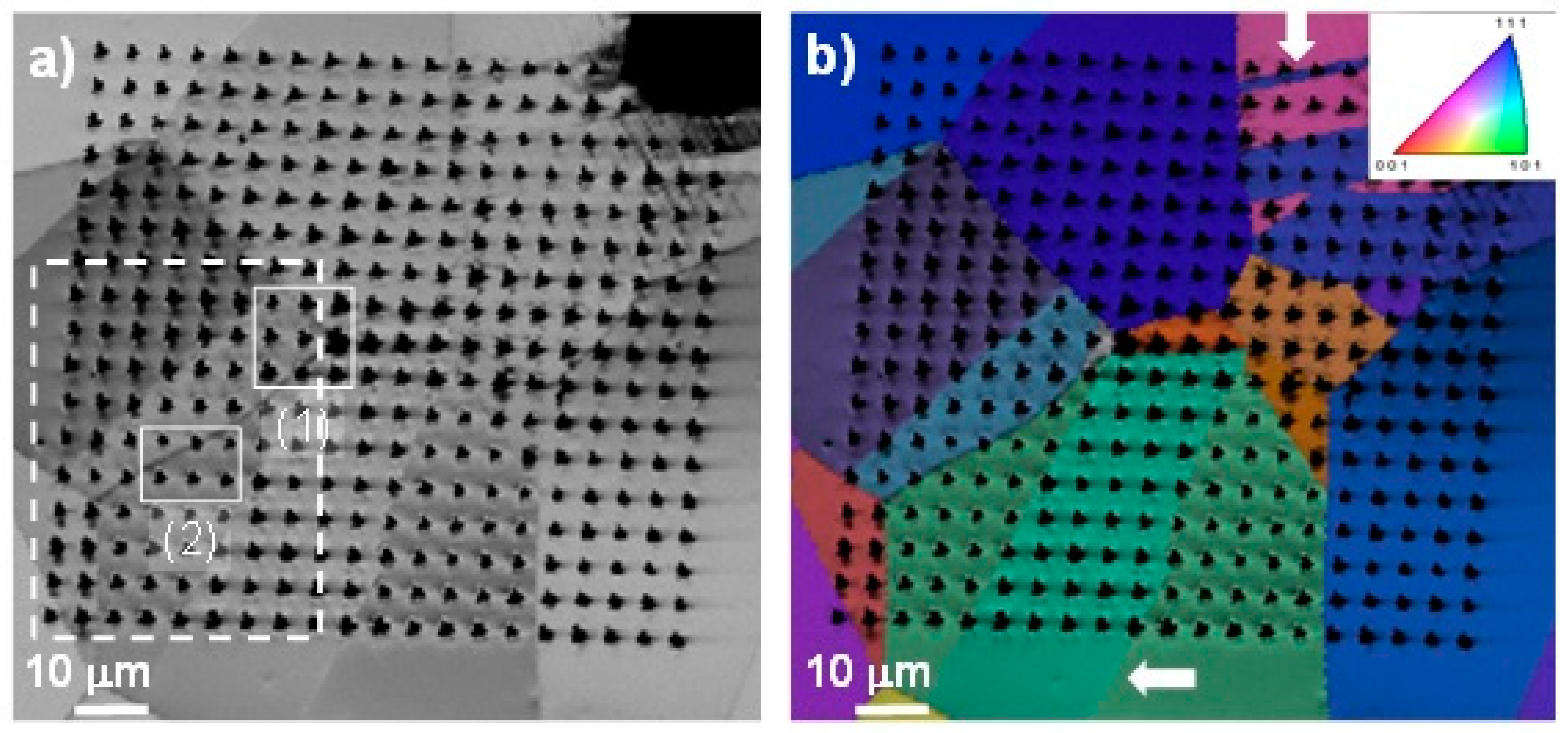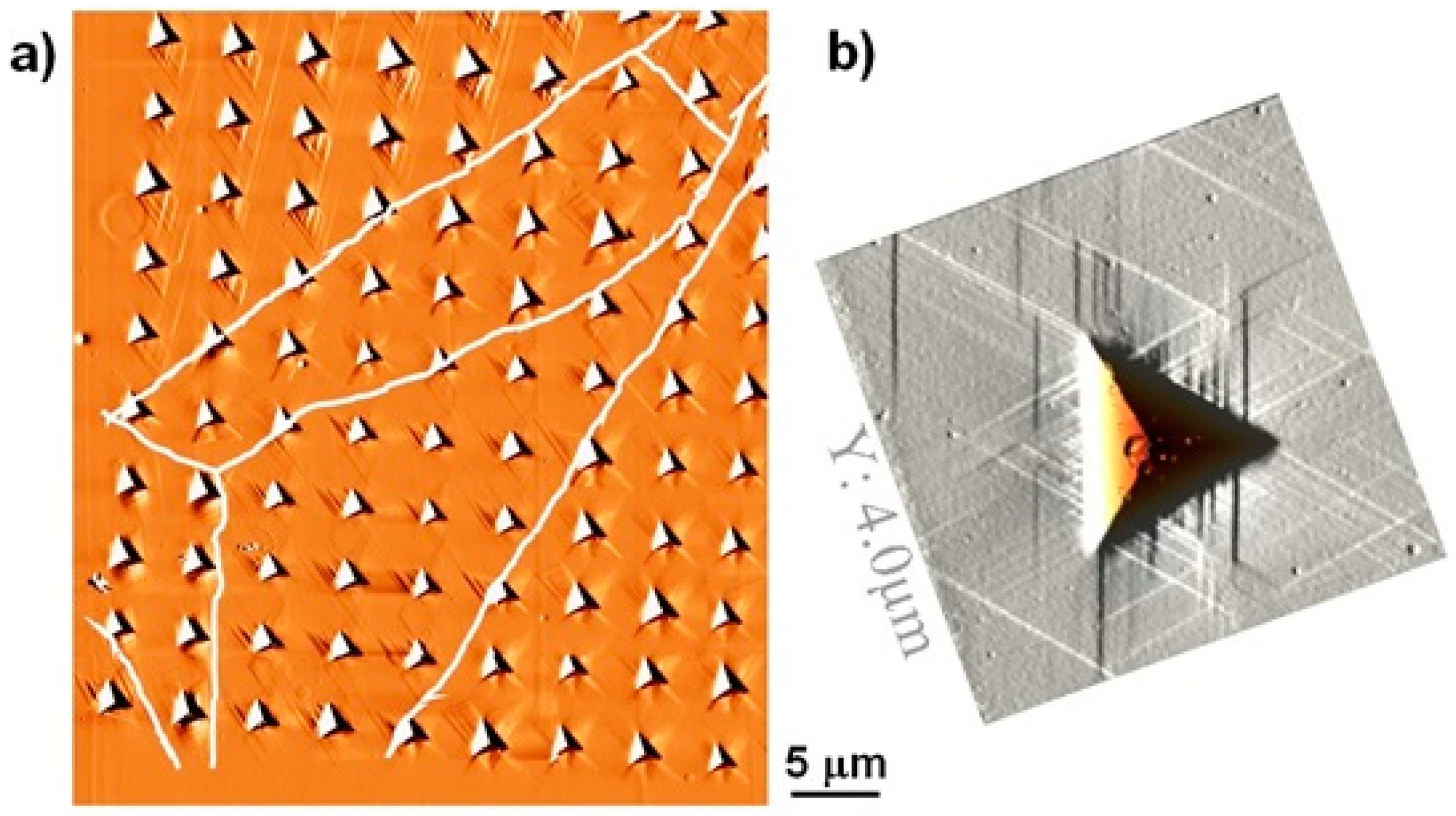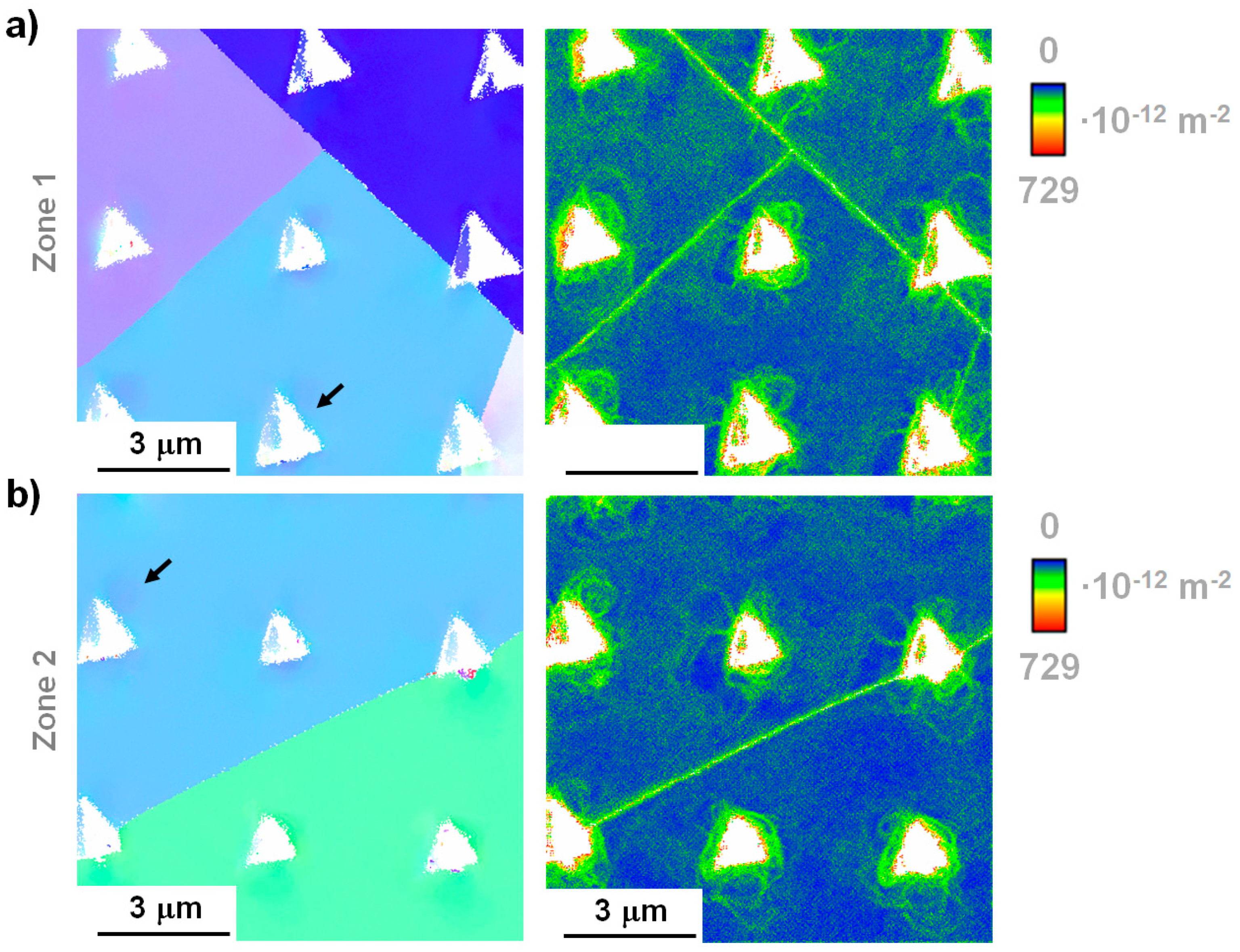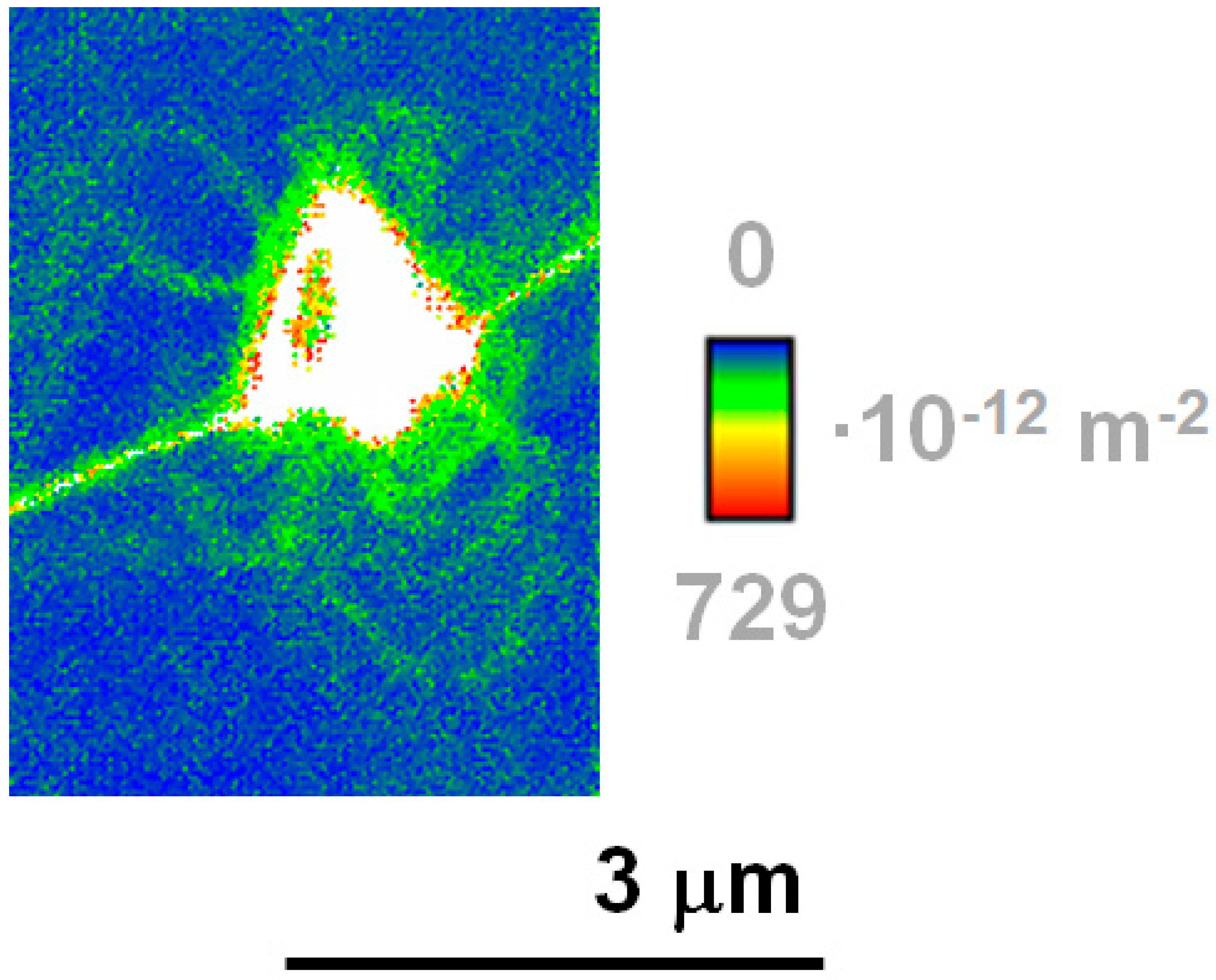Geometrically Necessary Dislocations on Plastic Deformation of Polycrystalline TRIP Steel
Abstract
:1. Introduction
2. Experimental Procedure
3. Results and Discussion
4. Conclusions
- (i)
- The nanomechanical tests conducted by using a sharp Berkovich indenter on individual austenitic grains led to the activation of the main deformation mechanisms. Hence, slip traces have been observed by advanced characterization techniques.
- (ii)
- A GND map methodology provides information regarding the complex stress fields induced by nanoindentation inside certain crystallographic orientations.
- (iii)
- Austenitic grains display an isotropic behavior regarding the GND maps, with the Frank–Read source being the main deformation mechanism.
- (iv)
- All these results can serve as valuable inputs for microstructurally informed computations aimed at predicting the flow behavior at the macroscopic length scale.
Author Contributions
Acknowledgments
Conflicts of Interest
References
- Vogt, J.-B.; Magnin, Z.; Foct, J. Effective stresses and microstructure in cyclically deformed 316L autenitic stainless steel: Effect of temperature and nitrogen content. Fatigue Fract. Eng. Mater. Struct. 1993, 16, 555–564. [Google Scholar] [CrossRef]
- Andersson, R.; Magnusson, C.; Schedin, E. Using stainless steel for energy absorbing components in automobiles. In Proceedings of the Second Global Symposium on Innovations in Materials Processing and Manufacturing: Sheet Materials, TMS Annual Meeting, New Orleans, LA, USA, 11–15 February 2001. [Google Scholar]
- Zandrahimi, M.; RezaBateni, M.; Poladi, A.; Szpunar, J.A. The formation of martensite during wear of AISI 304 stainless steel. Wear 2007, 263, 674–678. [Google Scholar] [CrossRef]
- Olso, G.B.; Cohen, M. A mechanism for strain-induced nucleation of martensitic transformations. J. Less Common Met. 1972, 28, 107–118. [Google Scholar] [CrossRef]
- Ludwigson, D.C.; Berger, J.A. Plastic Behavior of Metastable Austenitic Stainless steels. J. Iron Steel Inst. 1969, 207, 63–69. [Google Scholar]
- Fang, X.F.; Dahl, W. Strain hardening and transformation mechanism of austenitic stainless steels. Mater. Sci. Eng. A 1991, 141, 189–198. [Google Scholar] [CrossRef]
- Olson, G.B.; Cohen, M. Kinematics of strain-induced martensitic nucleation. Metall. Trans. A 1975, 6, 791–795. [Google Scholar] [CrossRef]
- Stringfellow, R.G.; Parks, D.M.; Olson, G.B. A constitutive model for transformation plasticity accompanying strain-induced martensitic transformation in metastable austenitic steels. Acta Metall. 1992, 40, 1703–1716. [Google Scholar] [CrossRef]
- Tomita, Y.; Iwamoto, T. Constitutive modeling of TRIP steels and its application to the improvement of mechanical properties. Int. J. Mech. Sci. 1995, 37, 1295–1305. [Google Scholar] [CrossRef]
- Serri, J.; Martiny, M.; Ferron, G. Finite element analysis of the effects of martensitic phase transformation in TRIP steel sheet forming. Int. J. Mech. Sci. 2005, 47, 884–901. [Google Scholar] [CrossRef]
- Shin, H.C.; Ha, T.K.; Chang, Y.W. Kinetics of deformation induced martensitic transformation in a 304 stainless steel. Scr. Mater. 2001, 45, 823–829. [Google Scholar] [CrossRef]
- Narutani, T.; Olson, G.B.; Cohen, M. Constitutive flow relations for austenitic stainless steels during strain-induced martensitic transformation. J. Phys. 1982, 43, 429–434. [Google Scholar]
- Cortés, J.A.; Tsuta, T.; Mitani, Y.; Osakada, K. Flow stress and phase transformation analysis in the austenitic stainless Steel under cold working—Part 1: Phase transformation characteristics and constitutive formulation by energetic criterion. JSME Int. J. 1992, 35, 201–209. [Google Scholar]
- Tsuta, T.; Cortés, J.A. Flow Stress and Phase Transformation Analyses in Austenitic Stainless Steel under Cold Working. Part 2, Incremental Theory under Multiaxial Stress State by the Finite-Element Method. JSME Int. J. 1993, 36, 63–72. [Google Scholar] [CrossRef]
- Levitas, V. Thermomechanical theory of martensitic phase transformations in inelastic materials. Int. J. Solids Struct. 1998, 35, 889–940. [Google Scholar] [CrossRef]
- Levitas, V.; Idesman, A.V.; Olson, G.B. Continuum modeling of strain-induced martensitic transformation of shear-band intereactions. Acta Mater. 1999, 47, 219–233. [Google Scholar] [CrossRef]
- Kubler, R.; Berveiller, M.; Cherkaoui, M.; Inal, K. Transformation textures in unstable austenitic steel. Trans. ASME 2003, 125, 12–17. [Google Scholar] [CrossRef]
- Garion, C.; Skoczen, M.; Sgobba, S. Constitutive modelling and identification of parameters of the plastic strain-induced martensitic transformation in 316L stainless steel at cryogenic temperatures. Int. J. Plast. 2006, 22, 1234–1264. [Google Scholar] [CrossRef]
- Tromas, C.; Stinville, J.C.; Templier, C.; Villechaise, P. Hardness and elastic modulus gradients in plasma-nitrided 316L polycrystalline stainless steel investigated by nanoindentation tomography. Acta Mater. 2012, 60, 1965–1973. [Google Scholar] [CrossRef]
- Taylor, M.D.; Choi, K.S.; Sun, X.; Matlock, D.K.; Packard, C.E.; Xu, L.; Barlat, F. Correlations between nanoindentation hardness and macroscopic mechanical properties in DP 980 steels. Mater. Sci. Eng. A 2014, 597, 431–439. [Google Scholar] [CrossRef]
- Furnémont, Q.; Kempf, M.; Jacques, P.J.; Göken, M.; Delannay, F. On the measurement of the nanohardness of the constitutive phases of TRIP-assisted multiphase steels. Mater. Sci. Eng. A 2002, 328, 26–32. [Google Scholar]
- Tjahjanto, D.; Turteltaub, S.; Suiker, A.; van der Zwaag, S. A Micromechanical Study of the Deformation Behavior of TRIP-Assisted Multiphase Steels as a Function of the Microstructural Parameters of the Retained Austenite. Adv. Eng. Mater. 2009, 11, 153–157. [Google Scholar] [CrossRef]
- Roa, J.J.; Fargas, G.; Mateo, A.; Jiménez-Piqué, E. Dependence of nanoindentation hardness with crystallographic orientation of austenite grains in metastable stainless steels. Mater. Sci. Eng. A 2015, 645, 188–195. [Google Scholar] [CrossRef]
- Kadkhodapour, J.; Schmauder, S.; Raabe, D.; Ziaei-Rad, S.; Weber, U.; Calcagnotto, M. Experimental and numerical study on geometrically necessary dislocations and non-homogeneous mechanical properties of the ferrite phase in dual phase steels. Acta Mater. 2011, 59, 4387–4394. [Google Scholar] [CrossRef]
- Sun, X.; Choi, K.S.; Soulami, A.; Liu, W.N.; Khaleel, M.A. On key factors influencing ductile fractures of dual phase (DP) steels. Mater. Sci. Eng. A 2009, 526, 140–149. [Google Scholar] [CrossRef]
- Roa, J.J.; Fargas, G.; Jiménez-Piqué, E.; Mateo, A. Deformation mechanisms under high cycle fatigue tests in a metastable austenitic stainless steel. Mater. Sci. Eng. A 2014, 597, 232–236. [Google Scholar] [CrossRef]
- Sapezanskaia, I.; Roa, J.J.; Fargas, G.; Turon-Viñas, M.; Trifonov, T.; Njiwa, R.K.; Redjaïmia, A.; Mateo, A. Deformation mechanisms induced by nanoindentation tests on a metastable austenitic stainless steel: A FIB/SIM investigation. Mater. Charact. 2017, 131, 253–260. [Google Scholar] [CrossRef]
- Roa, J.J.; Wheeler, J.M.; Trifonov, T.; Fargas, G.; Mateo, A.; Michler, J.; Jiménez-Piqué, E. Deformation of polycrystalline TRIP stainless steel micropillars. Mater. Sci. Eng. A 2015, 647, 51–57. [Google Scholar] [CrossRef]
- Field, D.P.; Trivedi, P.B.; Wright, S.I.; Kumar, M. Analysis of local orientation gradients in deformed single crystals. Ultramicroscopy 2005, 103, 33–39. [Google Scholar] [CrossRef] [PubMed]
- Horcas, I.; Fernández, R.; Gómez-Rodríguez, J.M.; Colchero, J.; Gómez-Herrero, J.; Baro, A.M. WSXM: A software for scanning probe microscopy and a tool for nanotechnology. Rev. Sci. Instrum. 2007, 78, 013705. [Google Scholar] [CrossRef] [PubMed]
- Lloyd, S.J.; Castellero, A.; Giuliani, F.; Long, Y.; McLaughlin, K.K.; Molina-Aldareguia, J.M.; Stelmashenko, N.A.; Vandeperre, L.J.; Clegg, W.J. Observations of nanoindents via cross-sectional transmission electron microscopy: A survey of deformation mechanisms. Proc. R. Soc. A Math. Phys. Eng. Sci. 2005, 461, 2521–2543. [Google Scholar] [CrossRef]
- Zaafarani, N.; Raabe, D.; Singh, R.N.; Roters, F.; Zaefferer, S. Three-dimensional investigation of the texture and microstructure below a nanoindent in a Cu single crystal using 3D EBSD and crystal plasticity finite element simulations. Acta Mater. 2006, 54, 1863–1876. [Google Scholar] [CrossRef]
- Brown, L.M. Slip circle constructions for inhomogeneous rotational flow. Mater. Sci. Forum 2007, 550, 105–117. [Google Scholar] [CrossRef]
- Zaafarani, N.; Raabe, D.; Roters, F.; Zaefferer, S. On the origin of deformation-induced rotation patterns below nanoindents. Acta Mater. 2008, 56, 31–42. [Google Scholar] [CrossRef] [Green Version]
- Hull, D.; Bacon, D.J. Introduction to Dislocations, 4th ed.; Elsevier Ltd.: New York, NY, USA, 2001. [Google Scholar]




© 2019 by the authors. Licensee MDPI, Basel, Switzerland. This article is an open access article distributed under the terms and conditions of the Creative Commons Attribution (CC BY) license (http://creativecommons.org/licenses/by/4.0/).
Share and Cite
Roa, J.J.; Suárez, S.; Guitar, A.; Fargas, G.; Mateo, A. Geometrically Necessary Dislocations on Plastic Deformation of Polycrystalline TRIP Steel. Crystals 2019, 9, 289. https://doi.org/10.3390/cryst9060289
Roa JJ, Suárez S, Guitar A, Fargas G, Mateo A. Geometrically Necessary Dislocations on Plastic Deformation of Polycrystalline TRIP Steel. Crystals. 2019; 9(6):289. https://doi.org/10.3390/cryst9060289
Chicago/Turabian StyleRoa, Joan Josep, Sebastián Suárez, Agustina Guitar, Gemma Fargas, and Antonio Mateo. 2019. "Geometrically Necessary Dislocations on Plastic Deformation of Polycrystalline TRIP Steel" Crystals 9, no. 6: 289. https://doi.org/10.3390/cryst9060289
APA StyleRoa, J. J., Suárez, S., Guitar, A., Fargas, G., & Mateo, A. (2019). Geometrically Necessary Dislocations on Plastic Deformation of Polycrystalline TRIP Steel. Crystals, 9(6), 289. https://doi.org/10.3390/cryst9060289








